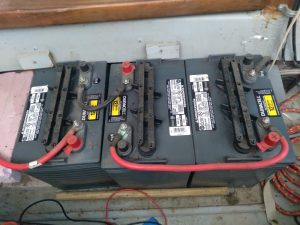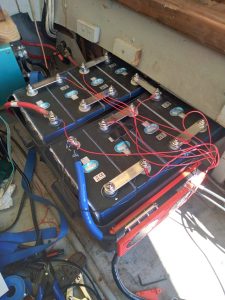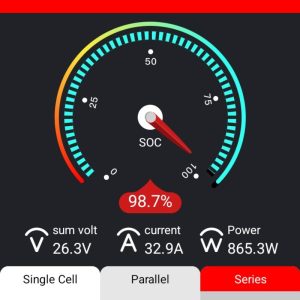It isn’t made pretty, yet, but the Sun King’s starboard battery bank is now a functioning Lithium Iron Phosphate (LFP) high capacity unit. Let’s look at the difference.
Here is the old battery: three 8v golf car batteries in series for 175 amp hours (ah). Since we try to only use 50% of a lead acid battery’s capacity, this will give us 3.5 hours of cruise at 25 amps. Weight is a total of 195 pounds. The battery bays have room for four 6v batteries, but I went with the 3×8 configuration to save 65 pounds on each side. With both banks, that’s 7 hours of cruise without anything from solar.

And here is the new battery. Two blocks of 4 cells are in standard plastic battery boxes. The Battery Management System (BMS) is bolted to the right side. The big blue and black cables are the negative side, with the BMS in between to interrupt the flow if the voltage or current are out of specification. The little wires that need to be tidied up are the not quite long enough balancer wires. The BMS monitors and adjusts each cell in the battery. The boxes are attached to each other and they take just a bit more room than two of the golf car batteries. Together they weigh about 100 pounds and are rated at 320 ah. With this battery, we can safely use 80% of the battery without shortening its life. That will give us over 10 hours of cruise, just on the starboard battery. 20 hours of cruise for the pair and power left over to fix supper.

The white strips in the black stripe atop the red BMS is where most of the accessories attach, the balancer plug is on the back end. There is a temperature sensor, which I have taped to the top of the battery. You don’t want to let a lithium battery get hot. It makes them angry. There is a connector for a “fuel gauge”, which also has the starter switch to wake up the battery. That takes a little getting used to. And, btw, if you are not using the battery it will shut off in an hour. Another attachment is a Bluetooth dongle so you can monitor the battery with your phone. Finally, there is a connector to plug into the USB on your laptop. This one frustrated me. The assembly was not quite right and I cannot get the cable fully plugged in. Perhaps a little adjustment with an Exacto Knife will help. This was after going raound and around trying to find the software and get a driver to run the application on Windows. I still have had no luck there. For the phone app, it went pretty smoothly, though without documentation I was not entirely certain of what all was going on.
.
A lot of what you need to know is there at a glance. There are some pages of things you need to set up and it is really scary in that there is no default set of useful parameters . For example, if you turned the battery on for the first time while attached to an inverter you might destroy the BMS because it has not been instructed to limit the huge current it takes to charge the inverter’s capacitors. I had started standalone and had no problem.
After some research, I gave it my best shot for parameters to give a use range of 80%. It was strange because the battery had been top charged before being shipped to me, so the output was much higher than what I want my normal 100% point to be. It is night now and the boat is all fired up with everything running, so it will get enough drained off overnight that I can see what should be happening with charging.
This actually went better than I would have hoped, so as soon as the additional battery boxes arrive, I may go ahead and convert both sides of the boat to lithium and skip a trial with a set of lead batteries in reserve. Remember, just one of these batteries holds more than twice the useful energy of one of the old sets.
Is there a downside to this conversion? We are saving 200 pound up front, which will make the boat more passenger friendly. On the other hand, that’s 200 pound less ballast down low to counter the high placement of the solar panels. This probably will not be an issue as the original configuration had 3 more panels up top, or 174 pounds. I think it will be a wash on issues of ballasting. The vast additional capacity of the new battery set should more than make up for the loss of the 3 solar panels, at least on trips under a week.
For the next installment I will try to offer some more details and maybe have some performance info if the river will soon get back under control. These trials will help decide the future power bank for the Solar Yacht projects.–Neal
